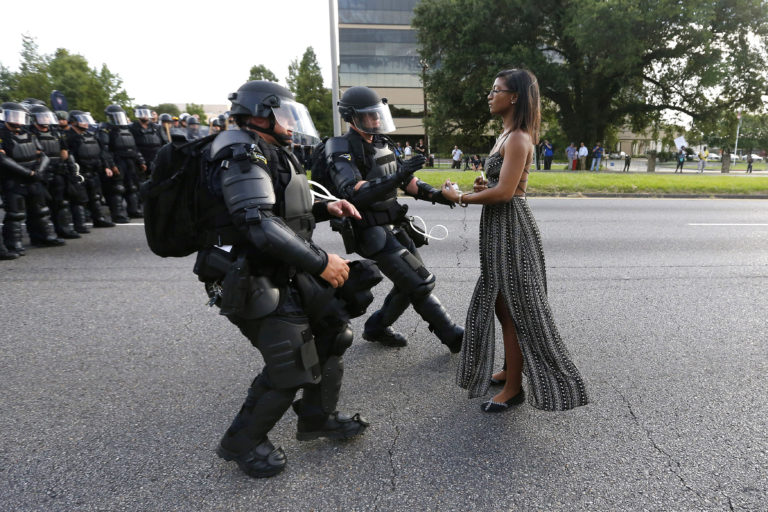
Ieshia Evans stands across from law enforcement at a protest in Baton Rouge, Louisiana on July 9, 2016. Image by Jonathan Bachman / Reuters, © All Rights Reserved.
As a Nation, Where Do We Stand?
There’s an old saying of unconfirmed origin:
“If you don’t stand for something, you’ll fall for anything.”
We have long used the word “stand” to signify the strength of our convictions. We “stand up to” bullies, “make a stand” for what is right, “refuse to stand” for what is wrong — the image of a firm physical stance connoting a firm inner core.
Science, it turns out, supports the metaphor. In a popular TED talk, social psychologist Amy Cuddy cites a research finding that a person who strikes a “power pose” — say, standing with shoulders back and hands on hips — releases chemicals that lead to better performance in job interviews.
Yogis know about this mind-body connection, too. To center in balance, they practice tadasana, or “mountain,” a seemingly simple pose in which feet are hip-width apart, the spine is straight, and arms are slightly lifted from the sides. Religious traditions also harness the power of standing: Protestants stand up to testify, Catholics stand and genuflect in a rhythm throughout Mass, Muslims stand to face Mecca five times a day.
The proverbial political stand made news last month when Democrats said they’d had enough of senseless gun deaths and partisan resistance to even voting on gun-control legislation. Civil rights legend John Lewis, the longtime representative from Georgia, summoned his colleagues to join him on the floor of the House of Representatives in defiance. Rep. John Larson of Connecticut echoed the call as members of Congress poured in to join them at the lectern:
“Rise up, Democrats. Rise up, Americans. This cannot stand. We will occupy this floor.”
The 25-hour protest ended up being a sit-in, of sorts: lawmakers sat cross-legged while they took turns giving fiery, often tearful speeches about lives lost to gun violence. One of the most poignant images of the day was of Rep. Tammy Duckworth of Illinois, an Iraq veteran who lost her legs in combat, out of her wheelchair sitting on the House floor. Ultimately, it was the peacefully disruptive presence of their bodies in one place — and their refusal to move — that mattered more than who stood or sat.
No major social movement has taken hold without such physical presence — crossing an Alabama bridge on Bloody Sunday, marching across western India to the Arabian Sea, gathering on a blood-stained street in Ferguson, Missouri. In 1921, the wives and daughters of striking coal miners in southeast Kansas made national news when they stood in front of mine entrances so that other men couldn’t take the company jobs.
Digital connections enliven today’s activism. Social media allows us to make direct, public appeals to our representatives, gather petition signatures, and organize campaign volunteers. During the gun-control sit-in, when House leaders turned off the cameras that fed to C-SPAN, representatives promptly tweeted and live-streamed the event from their mobile devices.
“Hashtag activism” gets a bad rap as being ineffectual, but merely tweeting our views indeed might change the world, if only through some butterfly effect of ideas. Technology’s greatest utility in taking a stand, though, might be in telling the public when and where to show up in real life.
That’s what happened in 2013, almost three years ago to the day of the House protest over gun violence. The Texas legislature was set to pass a bill that would shutter more than half of the state’s abortion clinics, severely limiting healthcare access for poor, rural, and Latina women in particular. State senator Wendy Davis tweeted her plan to stage a filibuster.
The tweet was shared thousands of times, and thousands of supporters flooded the state capitol to cheer her on.
Per Texas law, during the filibuster Davis couldn’t sit down, use the restroom, take a drink of water, speak off-topic, or even lean on her desk. She wore pink sneakers with her business clothes and for hours tearfully read testimonies about the dangers of chipping away at abortion rights. Just over an hour before midnight, at which point the anti-choice bill would be null, senate Republicans made a controversial ruling that she’d violated filibuster rules, in part by accepting from a colleague a back brace that was deemed a “leaning” device.
At this, women in the gallery erupted with outrage. “Bullshit!” they yelled. “Shame on you!” Then they stood up and started chanting. “Let her speak! Let her speak! Let her speak!”
It turned out Davis didn’t have to speak anymore. The crowd, which had filled all four tiers of the capitol rotunda, yelled and stomped so loudly that votes for the bill could scarcely be heard, let alone counted. The building shook. State troopers were ordered to clear the gallery, and some women refused to leave. In one video, a young woman puts her arms around a woman with graying hair to shield her from officers yanking violently on her arms. All the while, Davis was looking up at her roaring supporters, sometimes mouthing, “Keep it up.” They did — and the clock struck midnight before the bill could be passed.
It wasn’t just Davis’s filibuster that had won the day. It was a horde of like-minded Texans who read her tweet, piled into cars, walked into the Texas state capitol, and refused to relent.
Writer Callie Collins wrote of being at the capitol in Austin that day:
“It was an experience unlike any I’ve had — a moment when my voice and my body made a real, physical difference for something I believed in. It was electrifying and beautiful and visceral and sad, and, ultimately, successful.”
Legislatively, that success was short-lived. A similar bill later passed, limiting access to reproductive healthcare for millions of women. The pink sneakers Davis stood in that 2013 day, though, became an iconic image of 21st-century feminism. Like the recent gun-control sit-in, Sen. Davis’s stand achieved no immediate policy change but forced the nation to reckon with a minority voice that refused to yield.
Echoes of that voice — untold numbers of activists inspired by Davis’s filibuster — surely reverberated all the way to the United States Supreme Court, which last month struck down the Texas law for placing undue burden on female patients. It was the most pivotal abortion-rights decision in a generation.

In democracy and in life, there is a time for listening, for compromising, for being malleable. Those who shaped the greatest freedoms and promises of our union, though, reached a point at which a collective backbone was their most important asset. Some even managed to stand together with grace, refusing to match venom with more venom — but refusing, too, to give up.
In recent decades, we Americans, as a whole, seemed to have lost that backbone. Perhaps it was due to apathy born of privilege. Perhaps it was for disenfranchisement born of poverty, race, the erosion of civics education. Whatever the reason, as a country we sat down (mostly on couches) and shook our heads over somber news reports about the world. While we sat, extreme ideologies and destructive interests grew within our government and made ours a less safe, less equitable, less healthy, less free country in the name of religion, money, or both. Now, the presidential election and a host of public crises pose the question: As a nation, where do we stand?
In recent years, I’ve felt called to write and speak less as a reporter of events than as an advocate for the people most harmed by those events. As Holocaust survivor Elie Wiesel said in his 1986 acceptance of the Nobel Peace Prize:
“Neutrality helps the oppressor, never the victim. Silence encourages the tormentor, never the tormented. Sometimes we must interfere.”
Having been raised with different views than the ones I now hold, I’m sharply aware of the fallibility of ideas and will be the last to vilify those with whom I disagree. What now clarifies complicated issues for me, what tells me where to stand, is less a political or ideological line than the simple matter of suffering. Who is strategically barred from her constitutional rights? Who is senselessly murdered or harmed? Who struggles to feed a family? Whoever they are, I stand with them.

Share your reflection